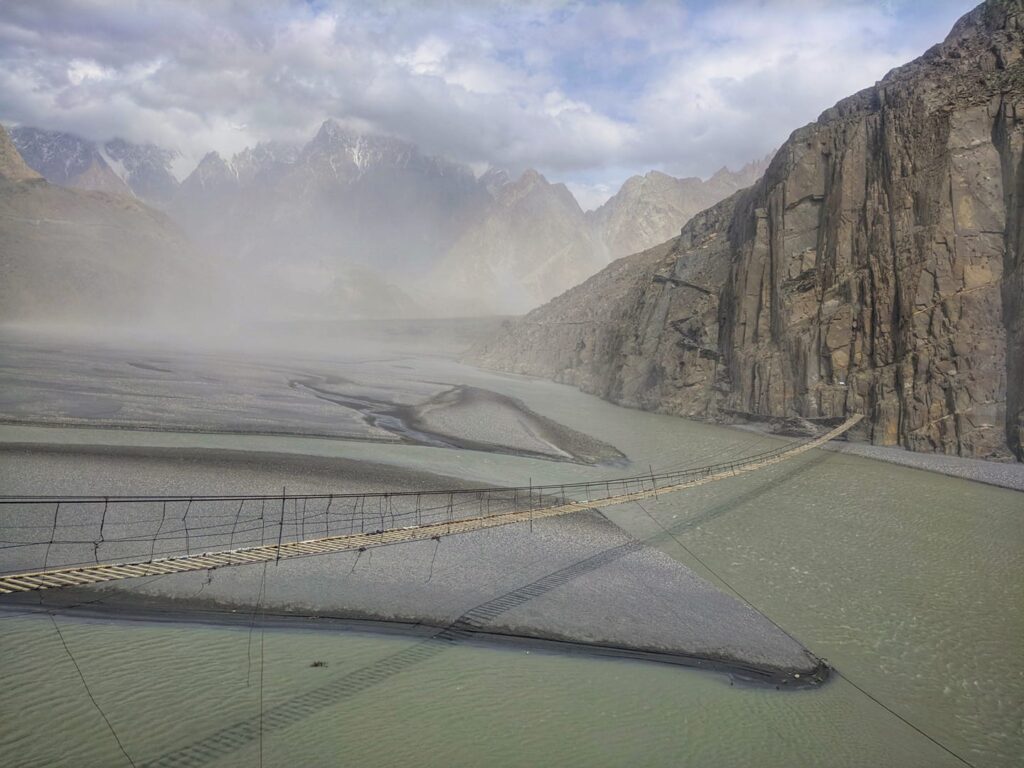Over the years, it has been “often referred to as one of the world’s most dangerous bridges”, mostly because of social media photos showing the old broken ropes that hang beside the new bridge. In reality, the walking bridge used today is maintained by the local community and is safe to cross with basic precautions.
The area around the bridge offers views of the Passu Cones, high Karakoram peaks, and the deep river valley. It has become one of the top attractions in Upper Hunza.
Geography of Hussaini Suspension Bridge
Location and Surroundings
The Hussaini Suspension Bridge is located in Hussaini village, Gojal Valley, within the Hunza District. The bridge lies right off the Karakoram Highway, making it easy to access. The area is surrounded by:
- The Karakoram mountain range
- Passu Cones
- Shisper Peak
- The Hunza River
The climate is cold for most of the year due to the elevation but you will not feel much of cold during bright sunny days specially in Summers.
Hussaini Bridge Location
Physical Details of the Bridge
- Length: 635 feet (194 meters) to 660 feet (201 meters)
- Material: Wooden planks tied with rope (Around 472 wooden planks)
- Height: Suspended around 50 feet above the river bed
- Walking difficulty: Moderate, could be tricky in windy weather or when there are too many people on bridge
- Wind conditions: Can be strong during afternoon hours, also depending on weather
The structure is simple, built with local resources and repaired when needed.

History of the Hussaini Suspension Bridge
Early Purpose of bridge
The bridge was originally built by villagers in 1968 to make a passageway between the Hussaini and Zarabod villages of the Upper Hunza over the Hunza River. It is also used by villagers for grazing livestock.
Before the 2010 Attabad Landslide
Before 2010, the bridge was known mainly among locals. The region was quieter, with fewer tourists. Most travelers passed through Hunza without exploring Gojal in depth. The bridge served villagers and had little publicity.
Read more about the 2010 Attabad Lake disaster
Impact of the 2010 Attabad Lake Disaster
In January 2010, a massive landslide blocked the Hunza River and created Attabad Lake. This disaster damaged roads, isolated communities, and brought worldwide attention to Hunza.
Images of the Hussaini Suspension Bridge circulated widely during news coverage. People began calling it “the most dangerous bridge” due to dramatic photos of the old damaged ropes hanging next to the functioning bridge.
Tourism increased sharply after this event, and the bridge became a symbol of both local hardship and adventure.
After 2010 and Present Condition
Today, the bridge is maintained regularly. A newer rope bridge stands beside the older one, which is damaged and left as a reminder of past difficulties. The working bridge is safe if crossed responsibly.
People and Culture of Hussaini Village
The Wakhi Community
The people of Hussaini belong to the Wakhi ethnic group. They speak the Wakhi language and follow traditions that have been passed down for generations.
Lifestyle and Economy
- Most families farm potatoes, wheat, and fruit.
- Livestock such as sheep and yaks are part of daily life.
- Tourism now supports many households.
- Women often make handicrafts such as embroidered caps and woolen items.
Wakhi culture places strong emphasis on hospitality, cooperation, and simple living in a harsh environment.
Why the Bridge Gained Global Attention
The label “one of the world’s most dangerous bridges” comes from:
- Images of the old broken bridge hanging beside the current one
- Wide gaps between planks
- Strong winds in the valley
- The fast-flowing Hunza River below
- Dramatic angles used by photographers
Although the phrase is used online, the bridge used today is stable when wind is calm. Locals cross it without fear because they are familiar with the structure.
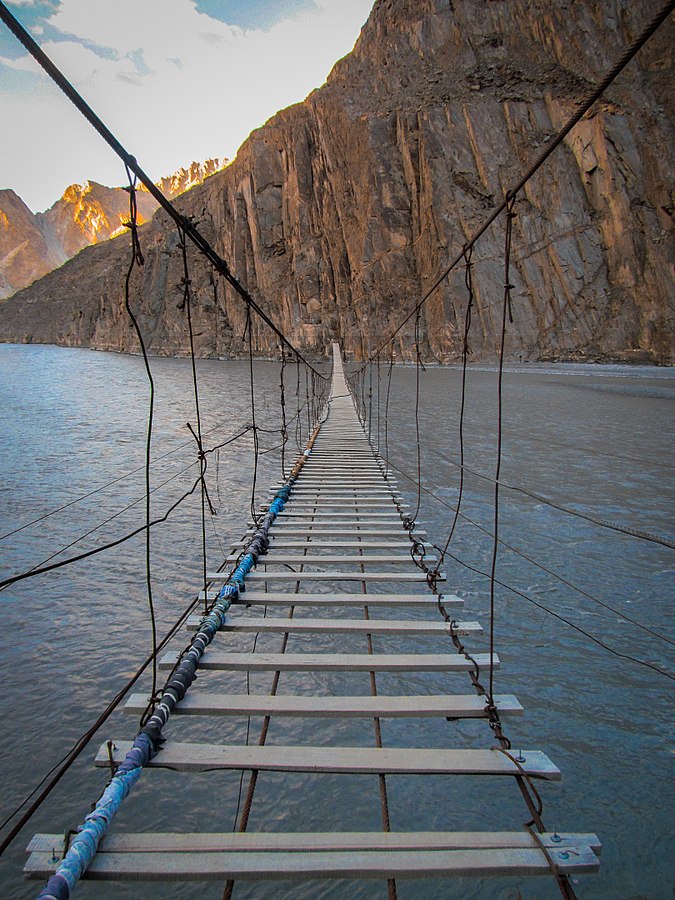
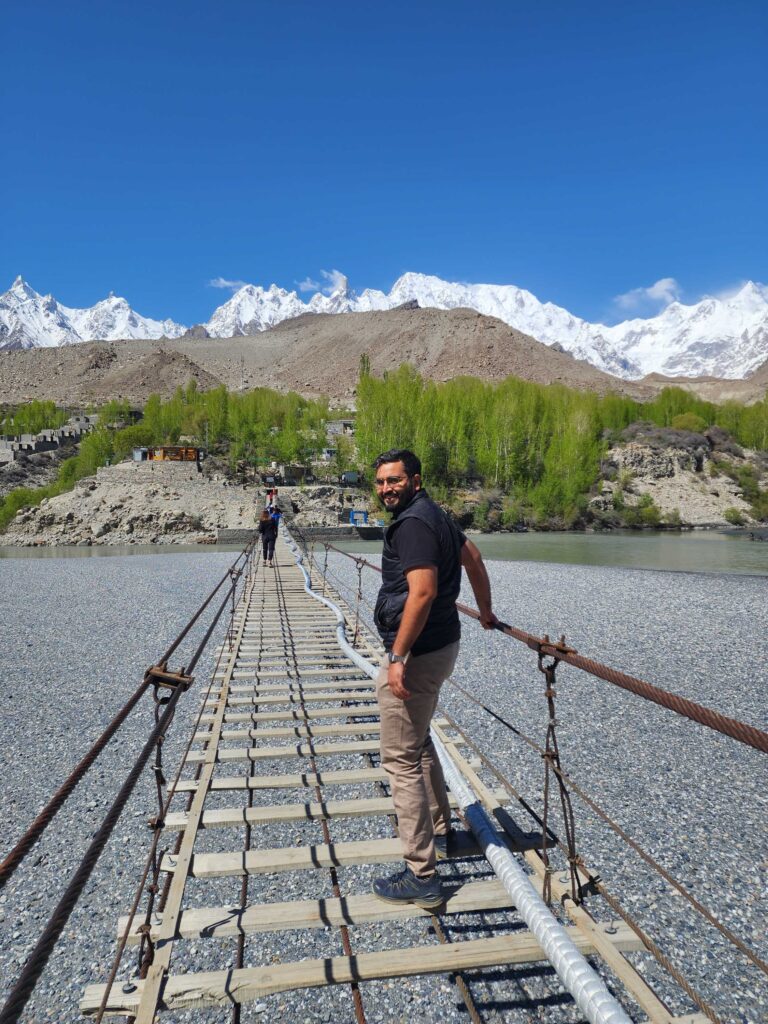
Notable Incidents and Interesting Facts
- No official fatal accidents are documented on the new restructured bridge. Locals mention an incident involving a tourist falling from the old bridge, but details are limited.
- Many international travel YouTubers filmed here, increasing its popularity.
- Seasonal river changes sometimes force repairs or tightening of ropes.
Weather and Best Time to Visit
Best Season
You can visit Hussaini Suspension bridge throughout the year. But ideal time to visit Hunza Valley is March-April (Cherry Blossoms season) and October-November (Autumn season).
Temperature
- Summer: 15°C to 30°C
- Winter: 10°C to -10°C
- Sudden cold winds are common
Winter is harsh, and winds make the bridge harder to cross but more adventurous.
How to Visit the Hussaini Suspension Bridge
Getting There
- From Karimabad: around 45 minutes
- From Gulmit: 10–15 minutes
- Accessible directly from the Karakoram Highway
- A short walk leads from the parking area to the bridge
This makes it suitable for families and tourists of all ages.
Entry Fee
Per Person: 200 Rs
Entry fee is collected by local villagers to use the money for repair and maintenance of bridge and to support local tourism.
Activities at Hussaini Bridge
A zipline has been set up near the bridge in recent years. It is a short ride operated by local adventure guides. The zipline gives a quick but exciting view of the river and the valley. Safety gear such as a harness and helmet is provided by the operators.
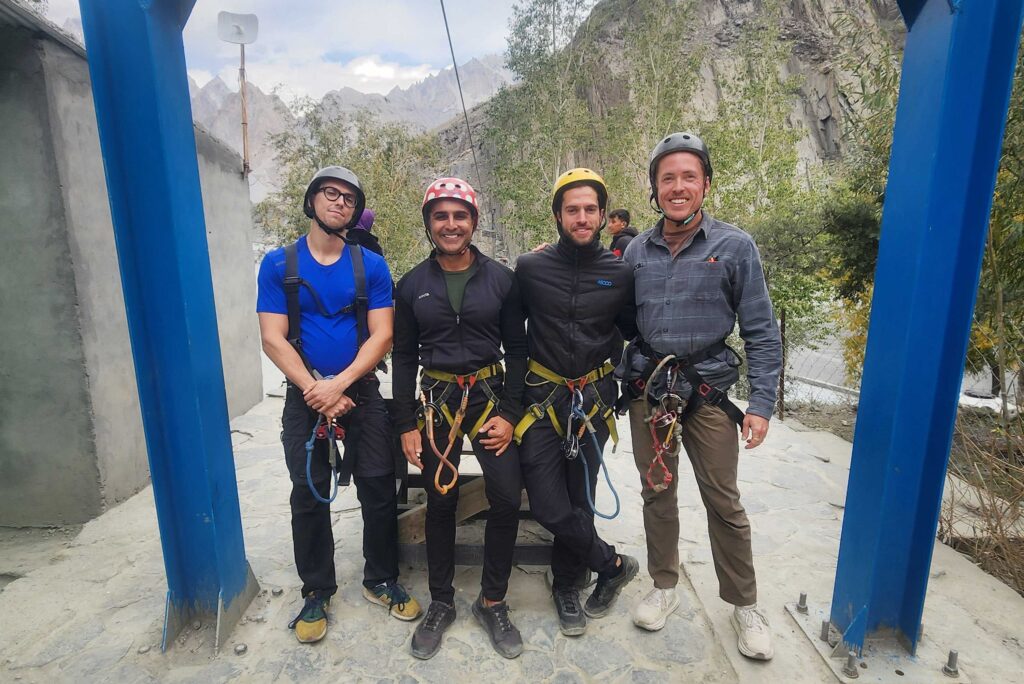
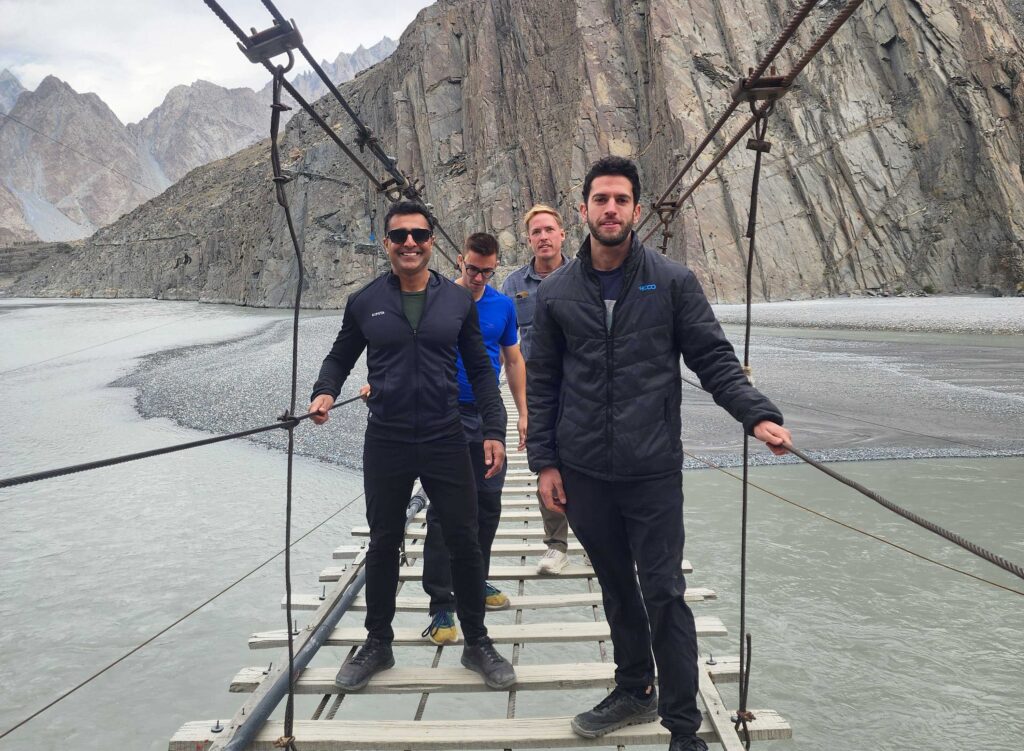
Safety Tips
- Hold the ropes firmly
- Avoid crossing during strong winds
- Wear shoes with good grip
- Keep distance between walkers
- Avoid swinging the bridge intentionally
- Don’t bring children on bridge
Nearby Attractions
These can be used for internal linking:
- Passu Cones – You can see the famous pointed peaks from the area, and this guide to the Passu Cones in Upper Hunza helps you understand their location and background.
- Attabad Lake – The bright blue lake is not far from the bridge, and this Guide to Attabad Lake Hunza gives useful details for planning a short visit.
- Gulmit Village – The nearby village offers a look into local life, and the Culture of Gulmit Hunza section explains its people, history, and traditions.
- Borith Lake – This quiet lake lies a short drive uphill, and the Borith Lake travel guide shares practical information for a peaceful visit.
- Passu Glacier – The glacier viewpoint is easy to reach, and the Passu Glacier viewpoint guide helps you know what to expect and how the landscape formed.
Hussaini Suspension Bridge Tours
Here are list of Hunza Valley tours which you can book to visit Hussaini Suspension Bridge.
Frequently Asked Questions (FAQs)
Is the Hussaini Suspension Bridge safe to cross?
The bridge is generally considered safe for visitors, but it still requires care because of the gaps between planks and strong winds. People with balance issues or fear of heights should be cautious.
How long does it take to cross the bridge?
Most visitors take around 10–15 minutes for a relaxed one-way crossing, depending on their pace and comfort level.
Is there an entry fee to visit the bridge?
Yes, locals usually charge a small fee of PKR 200 per person for maintenance of the area and to support the nearby community.
Are there activities near the Hussaini Suspension Bridge?
Besides crossing the bridge, visitors can enjoy a small zipline, short walks along the river, photography spots, and local tea stalls run by the community.
